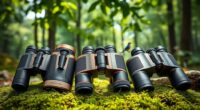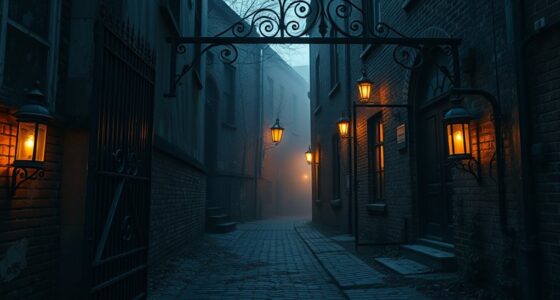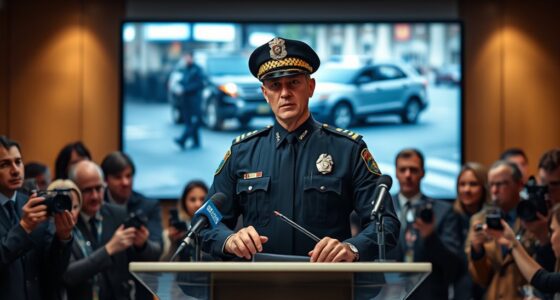To pick the right locations for your paranormal TV show, start with sites rich in history, legends, and stories that add depth and credibility. Make certain accessible, safe, and well-maintained environments for your crew and equipment. Get legal permissions and consider the location’s reputation for paranormal activity to boost audience interest. Don’t forget to evaluate visual elements and atmospheric authenticity; these details can make your show more immersive and memorable. To explore all these factors further, keep going.
Key Takeaways
- Prioritize locations with rich histories, legends, or past paranormal activity to enhance storytelling authenticity.
- Ensure site safety, accessibility, and proper infrastructure to protect crew and equipment during filming.
- Obtain all necessary permissions, permits, and legal clearances from property owners and authorities.
- Evaluate visual features like lighting, textures, and natural elements to create an eerie, immersive atmosphere.
- Consider seasonal factors, weather, and environmental conditions to maintain safety and filming quality.
Assessing the Historical Significance and Backstory

When evaluating potential locations for your paranormal TV show, understanding their historical significance is essential. You need to dig into the site’s past—who lived or worked there, notable events, and any legends tied to it. This background helps you craft a compelling narrative and guides your investigation approach. Research old records, newspapers, and archives to uncover details that might not be obvious during a quick visit. Knowing the history also helps you anticipate potential challenges, like structural issues or sensitive stories that require respectful handling. A location with a rich, well-documented backstory can add depth to your show, engaging viewers and lending credibility to your investigations. Additionally, understanding the core personality traits of the site’s past inhabitants can provide insights into the types of paranormal activity to expect. Ultimately, understanding a site’s history is the foundation for authentic and enthralling paranormal content.
Ensuring Accessibility and Safety for Crew and Cast
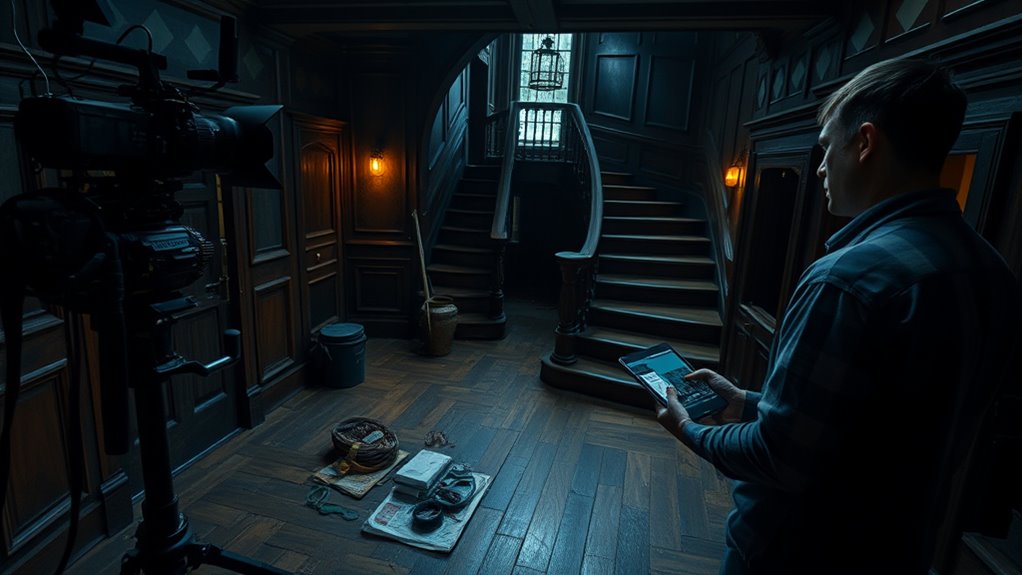
After uncovering a location’s historical background, it’s important to contemplate how accessible and safe it is for your crew and cast. Check the site’s access points—ensure there are clear paths and proper signage to prevent confusion or accidents. Confirm the building’s structural integrity, looking for hazards like unstable floors, loose railings, or exposed wiring. Verify that emergency exits are accessible and well-marked. Consider the availability of amenities such as restrooms, lighting, and power sources. You want everyone to work efficiently without risking injury or delays. Also, assess the location’s compatibility with safety regulations, ensuring you have the necessary permits and insurance coverage. Prioritizing safety considerations protects your team and ensures smooth filming, allowing you to focus on capturing the paranormal phenomena.
Evaluating the Authenticity of the Location’s Atmosphere

To capture an authentic atmosphere, you should consider the site’s historical significance and legends, as these stories add depth to your production. Listen for environmental soundscapes or moments of silence that enhance the eerie feeling, making the experience more convincing. Also, assess the visual authenticity by examining signs of decay or original features that support the location’s credibility. Paying attention to decor elements can further help establish a genuine farmhouse ambiance that resonates with viewers.
Historical Significance and Legends
Historical significance and legends breathe life into a location’s atmosphere, making it feel authentic and compelling for a paranormal TV show. These stories add depth and credibility, helping viewers connect with the site’s past. When evaluating a location, consider its history and local legends, as they often shape reported paranormal activity. Authentic legends can elevate your show’s credibility, while fabricated tales might undermine it. Use the table below to compare the strength of different legends and their impact:
| Legend Type | Credibility | Impact on Atmosphere | Audience Engagement | Supporting Evidence |
|---|---|---|---|---|
| Well-documented | High | Deepens authenticity | Increases interest | Historical records |
| Folklore | Moderate | Adds mystique | Engages curiosity | Oral traditions |
| Modern myths | Low | Might seem contrived | May distract viewers | Anecdotal reports |
Prioritize locations with genuine historical roots and compelling legends to create an immersive experience. Incorporating legend credibility enhances the overall atmosphere and viewer trust.
Environmental Soundscapes and Silence
Environmental soundscapes and silence are crucial indicators of a location’s authenticity, as they reveal whether the setting feels genuinely haunted or artificially staged. Pay attention to ambient noises like distant footsteps, creaking floors, or unexplained whispers—these sounds can add depth and realism to the atmosphere. Authentic locations often have natural, unpredictable sounds that aren’t artificially added or overly controlled. Silence can also be telling; prolonged quiet moments might suggest an untouched environment, while unnatural silence could hint at staging or suppression of natural sounds. Trust your instincts when evaluating the soundscape—if it feels organic and immersive, the location is more likely to deliver a genuine haunted atmosphere. Authentic sound environments greatly enhance the credibility of your paranormal investigations.
Visual Authenticity and Decay
When evaluating a location’s authenticity for a paranormal show, examining visual cues of decay and wear can reveal how genuine the atmosphere feels. Look for signs like peeling paint, broken windows, rusted fixtures, or weathered furniture, which suggest long-term neglect and age. Authentic settings often display uneven surfaces, faded wallpaper, or stained ceilings that tell a story of history and passage of time. Avoid locations that appear artificially aged or overly restored, as they can break immersion. Pay attention to lighting and shadows that highlight imperfections, enhancing the eerie vibe. Genuine decay adds depth and credibility to the atmosphere, making viewers feel transported to a real, haunted environment. Your eyes can be a powerful tool in spotting the difference between authentic wear and fake effects. Additionally, understanding building materials and their aging patterns can help distinguish between natural deterioration and artificial weathering techniques.
Considering Legal Permissions and Ownership Rights

Before filming at a location, you must secure the necessary legal permissions and ownership rights to avoid potential legal issues. Contact property owners or managers early to obtain written consent, ensuring you understand any restrictions or requirements. If the site is public, check local regulations or permits needed for filming. For private properties, clarify who holds the rights—whether it’s the owner or a tenant—and confirm you have permission to record there. Keep detailed records of all permissions and agreements in case questions arise later. Failing to secure proper authorization can lead to legal disputes, fines, or having to cease production. Being diligent upfront saves you time and protects your project from costly complications. Additionally, understanding property rights and ensuring compliance with local laws can help prevent potential legal challenges during or after filming.
Analyzing the Visual Appeal and Aesthetic Elements
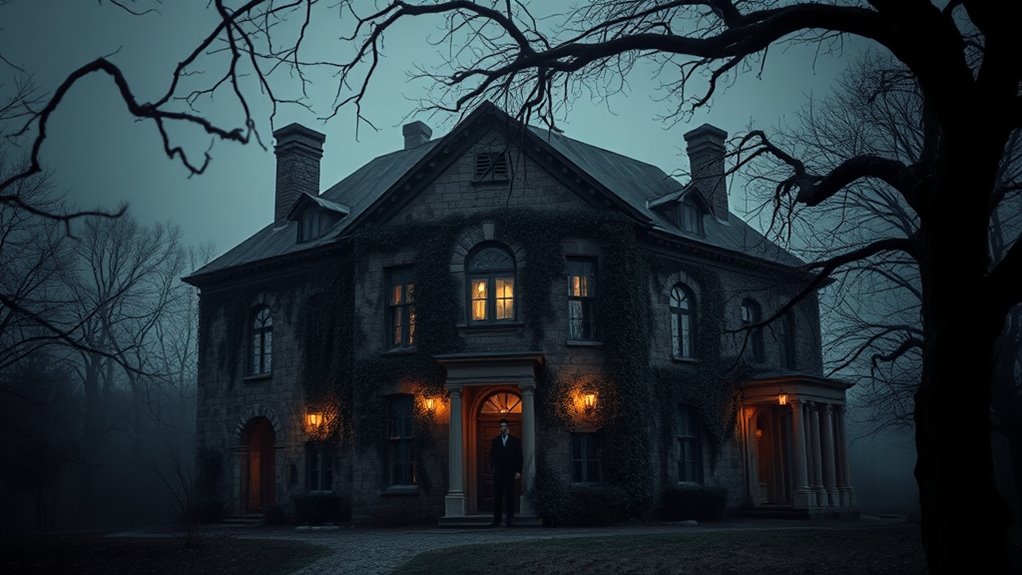
Securing permissions guarantees you can film without legal interruptions, but once those rights are in place, it’s time to focus on the location’s visual appeal. The right aesthetic can deepen the mystery and captivate your audience. Look for elements that create an eerie atmosphere, like shadows, textures, and lighting. Consider how the setting’s natural features evoke emotion and intrigue. To inspire your viewers, evaluate:
- The play of light and darkness that heightens suspense
- Unique architectural details that suggest history or secrets
- Textures and materials that add a tactile, unsettling feeling
- Visual cues that evoke curiosity or fear, like creaking floors or haunting landscapes
These elements can transform an ordinary location into a compelling backdrop for paranormal stories.
Determining the Availability of Necessary Infrastructure

Evaluating the infrastructure of a potential filming location is essential to guarantee smooth production. You need reliable power sources, accessible water, and sufficient internet connectivity to keep equipment running and communicate effectively. Without these, your shoot could face delays or technical issues. Check if the site has proper lighting, secure pathways, and enough space for crew movement. Consider storage options for gear and safety features like fire exits. Use this table to assess key infrastructure elements:
| Infrastructure Element | Availability | Notes |
|---|---|---|
| Power Supply | Adequate | Backup generators needed? |
| Water Access | Sufficient | For equipment or crew needs? |
| Internet Connectivity | Reliable | Essential for communication and data transfer |
Understanding the Location’s Reputation and Paranormal Activity Reports
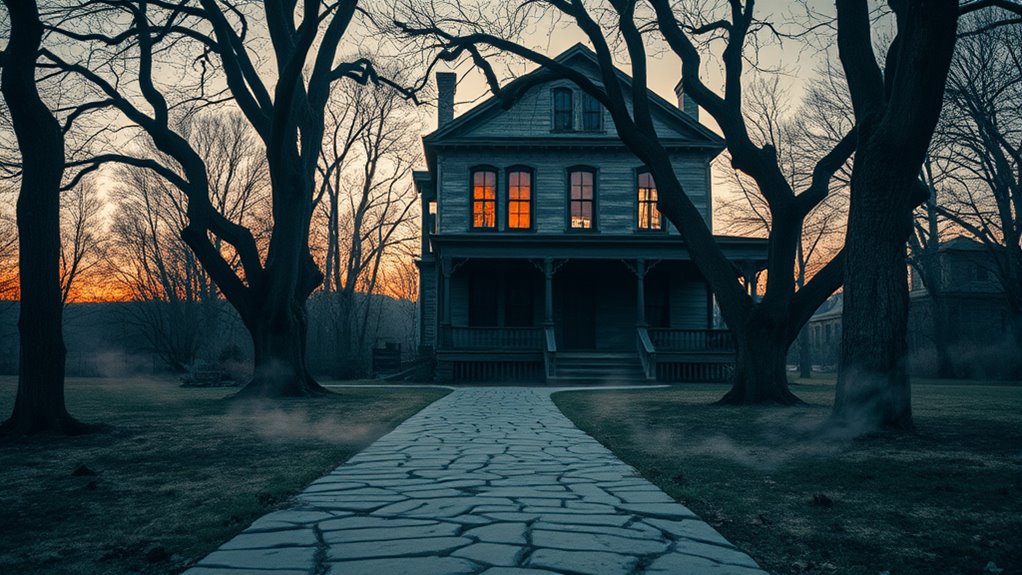
Understanding a location’s reputation and paranormal activity reports is essential for creating compelling content that resonates with viewers. It helps you gauge whether the site will truly captivate your audience and provide authentic experiences. Pay attention to:
- Local legends and stories that hint at unresolved mysteries, stirring curiosity and fear.
- Documented paranormal incidents that suggest ongoing activity, building anticipation.
- Historical significance that adds depth and emotional weight to your narrative.
- Community reports and testimonials that reinforce the location’s haunted reputation, heightening suspense.
- Recognizing textile art techniques that can be used to craft immersive backdrops or costumes, enhancing the storytelling environment.
Planning for Environmental and Seasonal Conditions
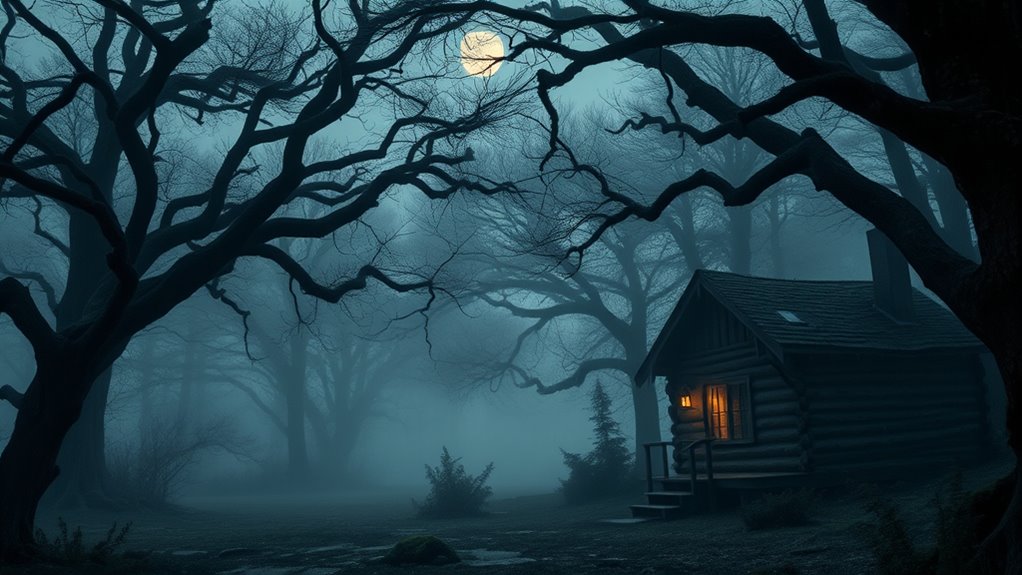
Planning for environmental and seasonal conditions is crucial to guarantee your paranormal investigation runs smoothly and safely. You need to assess weather patterns, temperature fluctuations, and humidity levels specific to your chosen location. Prepare for sudden changes, such as storms or cold snaps, which could impact equipment or your team’s safety. Consider how seasonal factors like snow, rain, or extreme heat might affect accessibility or the integrity of your investigation. Make sure to bring appropriate gear—like waterproof clothing, heating sources, or cooling devices—to adapt to these conditions. Additionally, check daylight hours and plan your schedule accordingly, since limited daylight can restrict your investigation time. Proper planning ensures you’re prepared for the environment, minimizing risks and maximizing your chances of capturing paranormal activity. Incorporating specialized equipment such as portable sensors and insulation can further enhance safety and data quality during your investigation.
Budgeting and Cost-Effectiveness of the Site
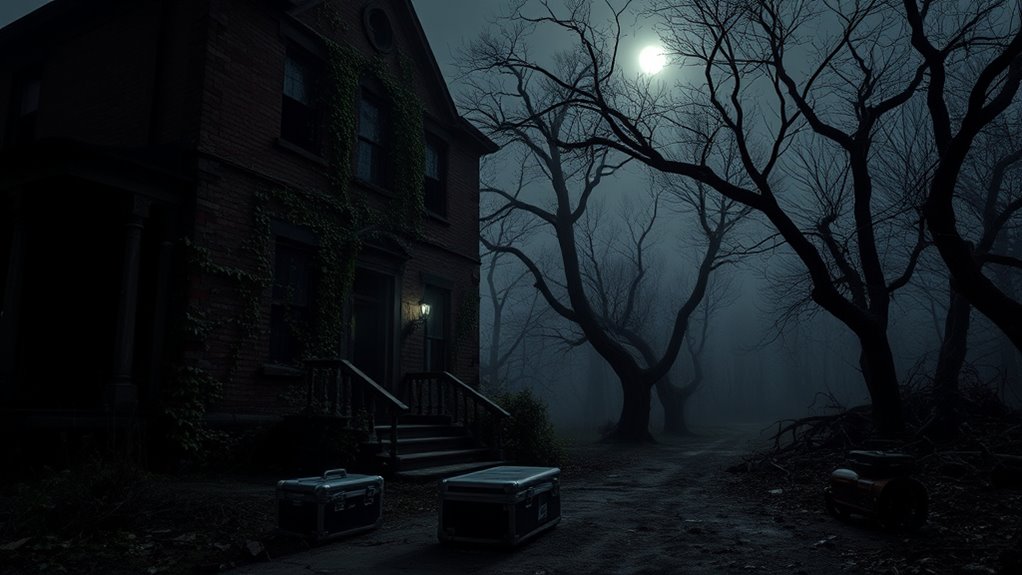
When evaluating a site, you need to ensure access expenses, including transportation and infrastructure costs. Permitting and insurance fees can quickly add up, so it’s essential to factor those into your budget from the start. Additionally, assessing equipment and staffing needs helps ensure your project stays financially feasible without compromising quality. Being aware of affiliate marketing disclosures can also be beneficial if seeking sponsorships or partnerships for your production.
Location Access Expenses
Budgeting for location access is essential because it directly impacts the overall cost-effectiveness of your paranormal TV show. Understanding the expenses involved helps you plan wisely and avoid surprises. Here are four key factors to contemplate:
- Entry Fees – Some sites charge for access, which can quickly add up and strain your budget.
- Time Limits – Limited access hours may force you to rush, risking missed footage or incomplete investigations.
- Additional Fees – Extras like security, cleanup, or special permissions can inflate costs unexpectedly.
- Location Restrictions – Certain sites restrict filming activities, potentially requiring costly negotiations or alternative plans.
- Additionally, considering the projector technology available can help optimize your filming setup and enhance visual clarity during shoots.
Being aware of these expenses allows you to make smarter choices, ensuring your show remains financially sustainable while capturing the perfect spooky moments.
Permitting and Insurance Costs
Securing the necessary permits and insurance is crucial because it protects your production from legal and financial risks. Permits ensure you have official approval to film at a location, preventing fines or shutdowns. Insurance covers potential damages, injuries, or liabilities that could arise during filming. Costs vary depending on the location’s regulations, the scope of your project, and the level of coverage needed. Budgeting for permits and insurance upfront helps avoid unexpected expenses that could derail your schedule or budget. It’s wise to research local requirements early and obtain quotes from insurance providers familiar with production needs. While permits and insurance add to your costs, they’re indispensable investments to safeguard your production against costly disputes or accidents. Proper planning here ensures smoother filming and better overall cost management.
Equipment and Staffing Budget
Allocating funds efficiently for equipment and staffing is essential to maximize your production’s quality without overspending. You need to balance investing in high-quality gear with hiring skilled personnel who can capture authentic paranormal moments. Proper budgeting ensures you avoid costly mistakes that could jeopardize your project.
Here are four key points to weigh:
- Prioritize versatile equipment that can handle multiple scenarios, saving costs in the long run.
- Hire experienced staff who can work efficiently, reducing time and resource waste.
- Allocate funds for contingency plans to cover unexpected expenses or equipment failure.
- Regularly review your budget to identify areas where you can cut costs without sacrificing quality.
Effective budgeting keeps your show compelling while maintaining financial control.
Frequently Asked Questions
How Can I Verify the Accuracy of Paranormal Activity Reports?
You can verify paranormal activity reports by cross-checking the details with multiple sources, including eyewitness accounts and local records. Use scientific tools like EVP recorders or infrared cameras to gather evidence firsthand. Talk to locals and experts for context. Be skeptical of sensational claims and look for consistent patterns or corroboration. This approach guarantees you rely on credible information, increasing your show’s authenticity.
What Are the Best Strategies for Negotiating Filming Rights?
You should start by clearly understanding the location owner’s needs and concerns. Offer fair compensation and be transparent about your filming plans. Build rapport by demonstrating professionalism and respect for their property. Negotiate terms that protect your interests while ensuring the owner feels valued. Put everything in writing, including rights, usage, and duration, to avoid misunderstandings. Flexibility and open communication are key to securing favorable filming rights.
How Do Weather Patterns Affect Filming Schedules at Haunted Locations?
You might find it surprising, but weather patterns can really throw off your filming schedule at haunted locations. Sudden storms or heavy fog can obscure visuals, delay shoots, or even damage equipment. You should plan for unpredictable weather by checking forecasts regularly and having backup dates. Plus, consider the location’s climate to make certain your crew stays safe and comfortable, so your paranormal stories stay authentic and uninterrupted.
What Safety Measures Should Be in Place for Crew During Paranormal Investigations?
You should guarantee your crew wears appropriate safety gear, like flashlights, first aid kits, and sturdy footwear. Establish clear communication protocols, including emergency signals and check-in procedures. Conduct thorough risk assessments of the location beforehand, and always have a plan for emergencies. Make sure someone is trained in first aid on-site, and keep access to emergency services. Prioritize safety to protect everyone during your paranormal investigations.
How Can I Assess the Long-Term Stability of a Location’s Paranormal Claims?
You need to become a paranormal detective, scrutinizing every claim with laser focus. Research historical records, interview locals, and look for consistent reports over years. Use scientific tools like EVP recorders or EMF meters to gather evidence that stands the test of time. If sightings or phenomena repeatedly occur under different conditions and are backed by credible witnesses, that location’s claims are likely stable and worth exploring long-term.
Conclusion
Choosing the right location can make or break your paranormal show. By weighing historical significance, safety, authenticity, and legal factors, you’ll find a spot that captivates viewers and enhances the story. Don’t forget to contemplate infrastructure and environmental conditions to keep production smooth. With careful planning, your show will deliver genuine chills. So, are you ready to uncover the perfect haunted setting that’ll keep audiences hooked?

